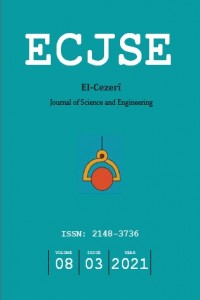(1E,1'E)-2,2'-tiobis(1-(3-mesitil-3-metilsiklobutil)etan-1-on) dioksim için sentez, Karakterizasyon ve teorik inhibitör çalışması
Öz
In this study synthesized and characterization of (1E,1'E)-2,2'-thiobis(1-(3-mesityl-3-methylcyclobutyl)ethan-1-one) dioxime for both experimental and computational was reported. The solid-state FT-IR spectrum was observed in the range of 4000–400 cm-1 and CDCl3 solvents were used for 1H and 13C NMR analysis. The molecular geometry was calculated using the Density Functional Theory (DFT/B3LYP) method in the ground state with the 6-31G(d, p) basis sets. Vibrational assignments and chemical shifts have been measured theoretically and compared to experimental data. B3LYP/6-31G(d,p) applied on our title compound to found different parameters such as the energy of the highest occupied molecular orbital (EHOMO), the energy of the lowest unoccupied molecular orbital (ELUMO), energy gap ( ΔE = ELUMO - EHOMO) and the dipole moment (μ) related to the corrosion efficacy of organic compounds whose molecular geometry and electronic properties are especially studied were calculated. Properties such as hardness (ɳ), softness (σ), electronegativity (χ) values were computed using these measurement results to inhibitor activity. The fraction of transferred electrons (ΔN) was also calculated, which determined the interaction between the iron surface and the organic compounds. Corrosion inhibitor behavior can therefore be predicted without an experimental study. The findings of the calculations show good relation between organic-based corrosion inhibitors and quantum chemical parameters process.
Anahtar Kelimeler
Kaynakça
- [1] Chakravorty A., "Structural chemistry of transition metal complexes of oximes", Coordination Chemistry Reviews, 1974, 13(1): 1-46.
- [2] Pavia D. L., Lampman G. M., Kriz G. S. and Vyvyan J., "Introduction to Spectroscopy, Brooks", Cole, Cengage Learning, 2009.
Synthesis, Characterization, and theoretical inhibitor study for (1E,1'E)-2,2'-thiobis(1-(3-mesityl-3-methylcyclobutyl)ethan-1-one) dioxime
Öz
In this study synthesized and characterization of (1E,1'E)-2,2'-thiobis(1-(3-mesityl-3-methylcyclobutyl)ethan-1-one) dioxime for both experimental and computational was reported. The solid-state FT-IR spectrum was observed in the range of 4000–400 cm-1 and CDCl3 solvents were used for 1H and 13C NMR analysis. The molecular geometry was calculated using the Density Functional Theory (DFT/B3LYP) method in the ground state with the 6-31G(d, p) basis sets. Vibrational assignments and chemical shifts have been measured theoretically and compared to experimental data. B3LYP/6-31G(d,p) applied on our title compound to found different parameters such as the energy of the highest occupied molecular orbital (EHOMO), the energy of the lowest unoccupied molecular orbital (ELUMO), energy gap ( ΔE = ELUMO - EHOMO) and the dipole moment (μ) related to the corrosion efficacy of organic compounds whose molecular geometry and electronic properties are especially studied were calculated. Properties such as hardness (ɳ), softness (σ), electronegativity (χ) values were computed using these measurement results to inhibitor activity. The fraction of transferred electrons (ΔN) was also calculated, which determined the interaction between the iron surface and the organic compounds. Corrosion inhibitor behavior can therefore be predicted without an experimental study. The findings of the calculations show good relation between organic-based corrosion inhibitors and quantum chemical parameters process.
Anahtar Kelimeler
Kaynakça
- [1] Chakravorty A., "Structural chemistry of transition metal complexes of oximes", Coordination Chemistry Reviews, 1974, 13(1): 1-46.
- [2] Pavia D. L., Lampman G. M., Kriz G. S. and Vyvyan J., "Introduction to Spectroscopy, Brooks", Cole, Cengage Learning, 2009.
Ayrıntılar
| Birincil Dil | İngilizce |
|---|---|
| Konular | Mühendislik |
| Bölüm | Makaleler |
| Yazarlar | |
| Yayımlanma Tarihi | 30 Eylül 2021 |
| Gönderilme Tarihi | 12 Haziran 2021 |
| Kabul Tarihi | 28 Temmuz 2021 |
| Yayımlandığı Sayı | Yıl 2021 Cilt: 8 Sayı: 3 |
Cited By
Quantum Chemical Study of Some Basic Organic Compounds as the Corrosion Inhibitors
Journal of Physical Chemistry and Functional Materials
https://doi.org/10.54565/jphcfum.1263803
Bromination of Chalcone
ARO-THE SCIENTIFIC JOURNAL OF KOYA UNIVERSITY
https://doi.org/10.14500/aro.11431
Synthesis and Diagnosis of New Heterocyclic Compound as Corrosion Inhibitor for Mild Steel in Acidic Solution
Diyala Journal of Engineering Sciences
https://doi.org/10.24237/djes.2024.17411
Açık Dergi Erişimi (BOAI)
Bu eser Creative Commons Atıf-GayriTicari 4.0 Uluslararası Lisansı ile lisanslanmıştır.





